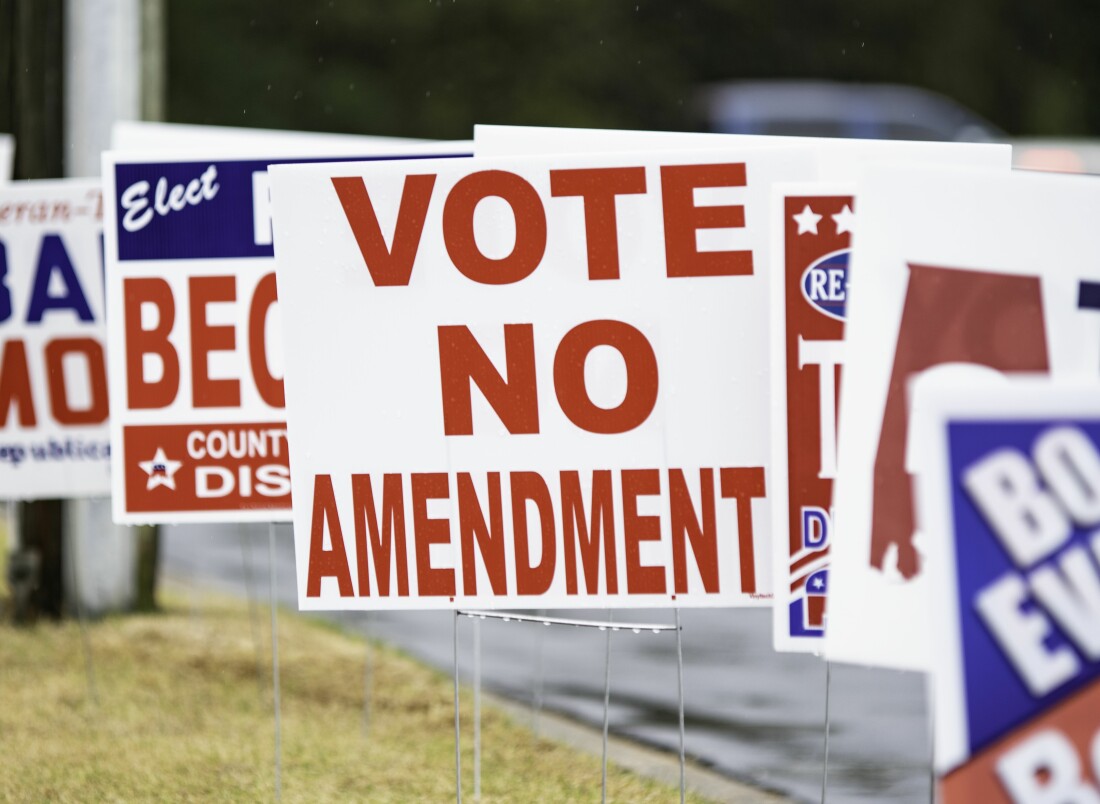Can We Ban That Sign?
 Revisiting Reed v Town of Gilbert & Its Impact on Local Sign Regulations. This blog has been updated with new information since its original publication in June 2021.
Revisiting Reed v Town of Gilbert & Its Impact on Local Sign Regulations. This blog has been updated with new information since its original publication in June 2021.
As the weather warms up, so does campaign season. This year, Michigan will hold elections for every U.S. House Seat, statewide seats such as Governor, Attorney General, and Secretary of State, state house and state senate seats, and numerous local elections. Already political signs are popping up across the state.
Typically, the location, duration, and characteristics of such signs are regulated by local ordinances. Before taking enforcement action against a nonconforming sign, it may be worth revisiting the constitutionality of each regulation.
Background
Six years ago, the U.S. Supreme Court upended local sign regulations with its decision in Reed v Town of Gilbert. In Reed, the Supreme Court held a sign ordinance’s restrictions were content based when the restrictions “depend[ed] entirely on the communicative content of the sign.” Courts have interpreted the broad ruling in Reed to mean a sign ordinance is unconstitutional if an official is required to read the sign’s message to determine which regulations apply.
Constitutional Analysis
When reviewing sign regulations, courts will first determine if the ordinance is content-based or content-neutral. A content-neutral ordinance does not target the sign’s communicative message, but instead applies to all signs regardless of their message. Content-neutral restrictions are usually limited to the time, place, and manner of the speech.
Content-neutral regulations get “intermediate scrutiny.” Intermediate scrutiny requires the restrictions to further an important governmental interest and be substantially related to that interest. Courts have found aesthetics, blight, and traffic safety to be examples of important government interests.
Content-based regulations target the communicative message of the expression and are subject to “strict scrutiny.” These restrictions are presumptively unconstitutional and are only permissible if they are narrowly tailored to serve a compelling interest using the least restrictive means. Strict scrutiny is almost always fatal.
In Reed, the court found the ordinance unconstitutional because it treated temporary use signs differently depending on whether they were political in nature, related to a qualifying event, or ideological.
Enforceability of Common Regulations
So what regulations are still enforceable? A good rule of thumb is that if the ordinance requires an official to read the sign to determine how it is regulated, then the ordinance is likely content-based and presumptively unconstitutional. Regulations that limit a sign’s size, location, illumination and lighting, and placement on public property are generally permissible because those regulations can be enforced without reviewing the sign’s message. Other restrictions require more analysis.
Time Restrictions — After an Event
Justice Alito, in his concurrence with the majority opinion in Reed, wrote, “[r]ules imposing time restrictions on signs advertising a one-time event” are permissible as content neutral. The Justice reasoned that rules limiting how long a sign may remain up after the relevant event has concluded are similar to rules limiting times within which oral speech or music is allowed. Those types of limitations have long been upheld by the court as content neutral under the time, place, and manner doctrine.
Time restrictions have been successfully challenged in the past. A federal court in Maryland held that durational limits on political signs displayed by private residences were unconstitutional.[1] But that appears to be the minority position. The D.C. Circuit Court, taking its cue from Justice Alito, upheld an ordinance that required signs related to a specific event to be removed within 30 days after the event’s conclusion. While the court noted its ruling seemingly conflicts with Reed, the court drew a distinction between targeting the sign’s message and drawing general distinctions between event-based signs and non-event signs. The court’s holding reflected the “common-sense understanding that, once an event has passed, signs advertising it serve little purpose and contribute to visual clutter.”[2]
For now, it seems municipalities can require event-related signs to be removed within a certain number of days after the event ends.
Time Restrictions — Before an Event
While courts are split on post-event removals, they generally disfavor time restrictions on the display of political signs before an election. Multiple courts have struck down ordinances that only permitted political signs to be displayed during a period of 45 days before the election.[3] Given that political signs must be regulated in the same manner as other temporary signs, it is likely sign ordinances cannot limit the time a sign can be displayed prior to an event.
On-Premises vs Off-Premises
In his list of still-permissible regulations, Justice Alito predicted that restrictions based on whether a sign is on- or off-premises would still survive scrutiny after Reed. The Sixth Circuit, which includes Michigan, disagrees.
On-premises signs are signs that relate to the use or purpose of the real property for which the sign is physically located. Sign ordinances frequently allow on-premises signs (especially to identify a business) but restrict or prohibit off-premises signs. The Sixth Circuit found this distinction to be content-based, calling it “neither a close call nor a difficult question.”[4] The court found Reed prohibits the ordinance from differentiating between on- and off-premises signs because such distinction is based on the sign’s message, i.e. whether it relates to the property or not. This only applies to non-commercial speech.
Sign ordinances that prohibit off-premises, non-commercial signs are unconstitutional. This includes ordinances that do not permit businesses to display non-commercial signs (like a political or ideological sign).
Profanity
The use of profanity on signs, especially on political signs, is not addressed by Reed but worth addressing given the rise in profane language on signs in during the 2020 election cycle. Profanity is protected speech under the First Amendment so long as it is not lewd. The Supreme Court is unwilling to curtail speech simply because it contains obscene language.[5] See Cohen . . . The court, in Cohen, conceded that the use of the f-word in political speech was “distasteful,” but protected by the Constitution — after all, “one man’s vulgarity is another’s lyric.”
Signs cannot not be removed because of the use of profane language, even if the sign draws a number of complaints from neighbors.
Conclusion
The Constitution requires justice to be blind and municipal officials to be illiterate. If your sign ordinance requires you to read the sign — with the possible exception of reading it to distinguish between event and non-event signs — then the regulation is likely unconstitutional.
If you have any questions or would like a review of your sign ordinance, please contact your Foster Swift attorney or one of the authors of this article.
Laura J. Genovich | 616.726.2238 | lgenovich@fosterswift.com
[1] See Curry v Prince George’s County, 33 F. Supp. 2d. 447 (D. Md. 1999.)
[2] ANSWER v District of Columbia, 846 F.3d. 391, 403 (D.C. Cir. 2017).
[3] See, e.g., Dimas v City of Warren, 939 F. Supp. 554 (E.D. Mich. 1996), Curry v. Prince George’s County, 33 F. Supp. 2d. 447 (D. Md. 1999).
[4] Thomas v Bright, 937 F.3d 721 (6th Cir. 2019).
[5] Cohen v California, 403 US 15 (1971).
Categories: Alerts and Updates, Compliance, Did you Know?, U.S. Supreme Court

Laura's practice focuses on bankruptcy, municipal law, collections, and trial-level and appeals litigation. In the bankruptcy arena, she represents primarily Chapter 7 trustees. Laura has handled a wide range of trial and appellate matters for individual and business clients and has appeared before the U.S. Sixth Circuit Court of Appeals, the Michigan Court of Appeals, and the United States Bankruptcy Court for the Western District of Michigan, as well as Michigan circuit and district courts across the state.
View All Posts by Author ›


 Share
Share